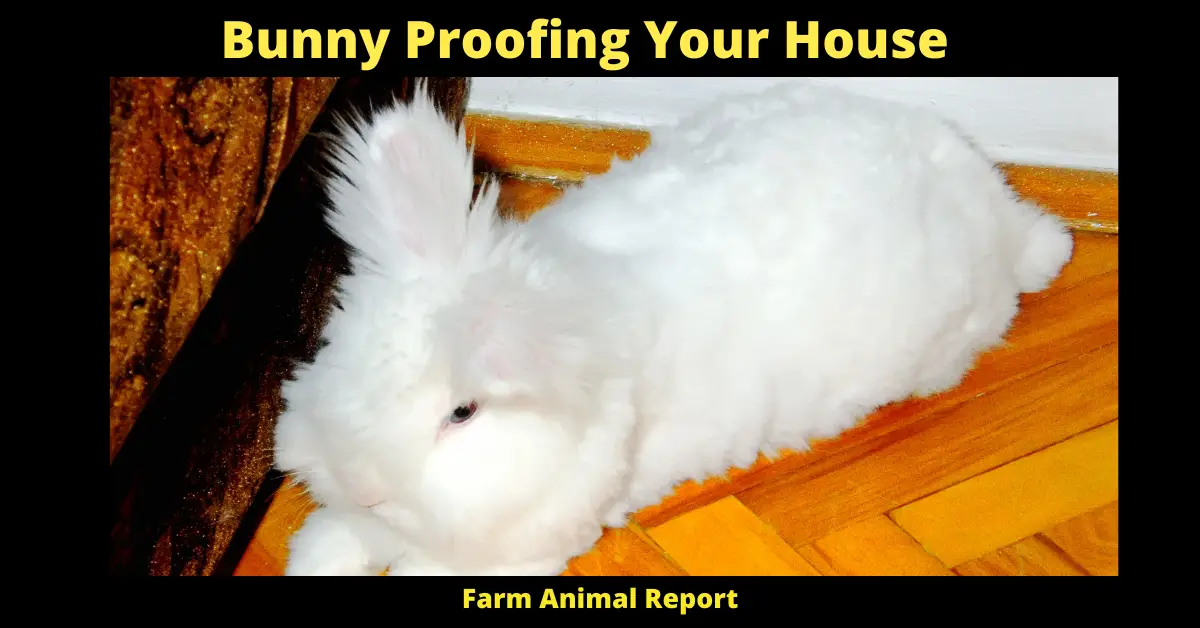As a general rule keeping your Bunny indoors, certain precautions need to be made. Bunnies love to chew, so wires, furniture, plants, baseboards, trash containers, carpets, and cabinets are all tasty morsels. They need litter boxes, cages, and training so that as they live with you they do not destroy your house.
Bunny Proofing Your House
For many pet owners, Bunny Proofing Your House is a necessary evil. You love your Bunny and want to give them the freedom they need to be happy in their home, but you want to keep it safe at the same time. Bunny proofing can seem daunting, but with these 18 tips.
Toxic Plants
Bunnies love to nibble on plants. Unfortunately, many common household plants are toxic to Bunny’s sensitive digestive system and can lead to serious health problems if Bunny ingests them. If you have any of these in your home, be sure Bunny stays away –
- Aconitum napellus (Monkshood or Wolfsbane)
- Amaryllis
- Anemone/Windflower
- Arum Lily
- Autumn Crocus (Colchicum)
- Azalea or Rhododendron leaves and blossoms. Bunny ingesting even a little bit of this can cause vomiting, diarrhea, cardiac problems, the potential for coma, and even death.
- Buttercup
- Caladium
- Calla Lily (Zantedeschia) – Bunny ingesting even a little bit of this can cause vomiting, diarrhea, and cardiac problems. Bunny may also be at risk for coma and death with ingestion of the Calla lily.
- Castor Bean or Castor Oil Plant – Bunny ingesting even a little bit of this can cause vomiting, diarrhea, and tremors. Bunny may also be at risk for coma and death with ingestion of the Castor Bean plant.
- Chrysanthemum
- Crocus (Autumn) – Bunny ingesting even a little bit of this can cause vomiting, diarrhea, and cardiac problems. Bunny may also be at risk for coma and death with ingestion of the autumn crocus.
- Daffodil – Bunny ingesting even a little bit of this can cause vomiting, diarrhea, and cardiac problems. Bunny may also be at risk for coma and death with ingestion of daffodils or other toxic members in the family Amaryllidaceae.
- Dumb Cane – Bunny ingesting even a little bit of this can cause vomiting, diarrhea, and cardiac problems. Bunny may also be at risk for coma and death with ingestion of the dumb cane plant.
- English Ivy – Bunny ingesting even a little bit of this can cause vomiting, drooling, loss of muscle control, and cardiac problems. Bunny may also be at risk for coma and death with ingestion of English Ivy.
- Foxglove – Bunny ingesting even a little bit of this can cause vomiting, diarrhea, and cardiac problems. Bunny may also be at risk for coma and death with ingestion of the Foxglove plant or other plants in Digitalis purpurea.
- Hemlock – Bunny ingesting even a little bit of this can cause drooling, loss of muscle control, and cardiac problems. Bunny may also be at risk for coma and death with ingestion of hemlock or other toxic members in the family Coniaceae.
- Iris
- Lily-of-the-Valley – Bunny ingesting even a little bit of this can cause vomiting, diarrhea, and cardiac problems. Bunny may also be at risk for coma and death with ingestion of the lily-of-the-valley plant or other plants in the family Convallariaceae.
- Monkshood – Bunny ingesting even a little bit of this can cause vomiting, diarrhea, and cardiac problems. Bunny may also be at risk for coma and death with ingestion of the Monkshood plant or other plants in Aconitum.
- Morning Glory
- Nightshade – Bunny ingesting even a little bit of this can cause drooling, loss of muscle control, and cardiac problems. Bunny may also be at risk for coma and death with ingestion of the nightshade plant or other plants in the family Solanaceae.
- Oleander – Bunny ingesting even a little bit of this can cause drooling, loss of muscle control, and cardiac problems. Bunny may also be at risk for coma and death with ingestion of oleander.Bunny may also be at risk for coma and death with ingestion of plants in Nerium oleander.
- Peace Lily – Bunny ingesting even a little bit of this can cause vomiting, diarrhea, and cardiac problems. Bunny may also be at risk for coma and death with ingestion of peace lily or other toxic members in the family of Araceae.
- Pothos – Bunny ingesting even a little bit of this can cause vomiting, diarrhea, and cardiac problems. Bunny may also be at risk for coma and death with ingestion of the pothos plant or other plants in Scindapsus.
- Rhododendron – Bunny ingesting even a little bit of this can cause drooling, loss of muscle control, and cardiac problems. Bunny may also be at risk for coma and death with ingestion of rhododendron or other toxic members in the family Ericaceae.
- Rhubarb – Bunny ingesting even a little bit of this can cause diarrhea, vomiting, tremors, and cardiac problems. Bunny may also be at risk for coma and death with ingestion of rhubarb or other plants in the family Polygonaceae.
- Tulip – Bunny ingesting even a little bit of this can cause diarrhea, vomiting, tremors, and cardiac problems. Bunny may also be at risk for coma and death with ingestion of tulips.
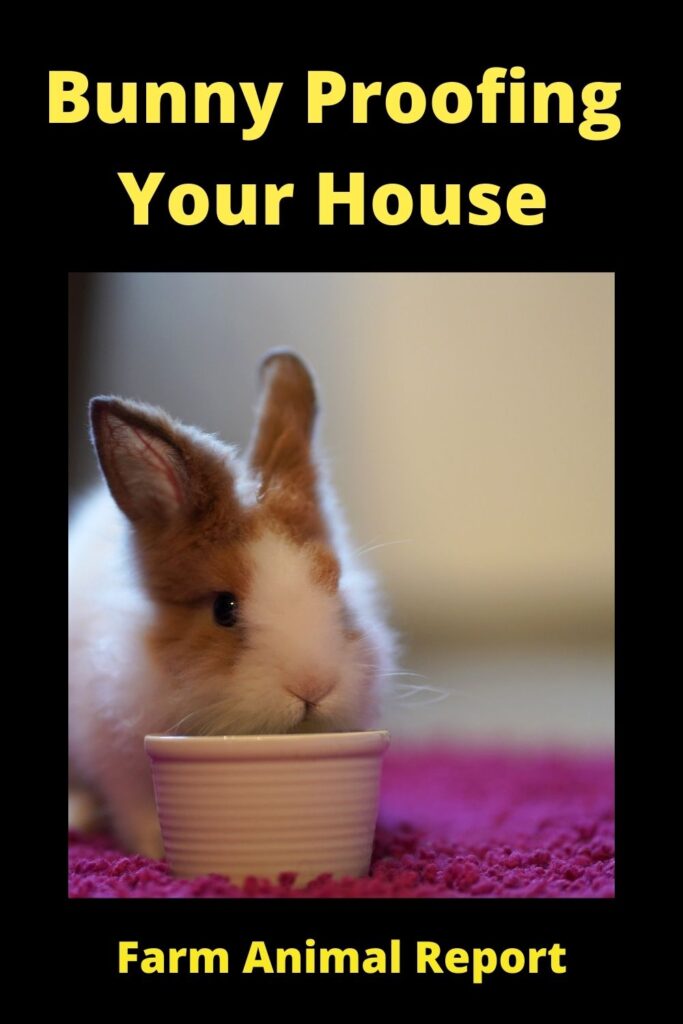
Tasty Electrical Wire
Bunny Proofing Your House – Today’s electrical components instead of using motor oils and lubricants have gone more green and use mineral, animal oils in their manufacturing processes, the side problem is that they can be quite tasty to a rabbit. Many a Vehicle owner has gone out to start his car only to find a small creature’s nest has been built and wires completely chewed through.
Electrical Cords
Pet Rabbits love to chew and electrical cords can be fatal. Bunny may chew on the cords and cause burns in her mouth or even electrocution.
Discourage Bunny from chewing by using cord covers like plastic tubing, split loom, and wire channels. You can also use heavy gauge electrical tape to block Bunny’s access to these cords.
If your Bunny is outside and you are using a heating pad or electric heating to prevent water freezing, keep them out of Bunny’s reach. Bunny may chew on the cords and cause burns in her mouth or even electrocution.
Bunny may chew on cords until they are bare, exposing live wires which cause shock or fire hazard if Bunny chews further into live wires directly under the insulation. The bunny should not have access when appliances are plugged in but turned off or unplugged when Bunny is out
18 Ways to Make Money by Rabbit Farming—Extensive Guidelines for Rabbit Farmers
Telephone Cords
Telephone cords also can be tempting for Bunny.
Chewing Computer Equipment
Today so many devices have cords many are signal cords so do not pose electrocution danger but can be bunny targets of chewing. This can Include
- Power cords
- USB Cords
- HDMI cables
- Cat 5 Cables
- Wireless Router Wires
- Cable TV signal cables
Carpet
Rabbits love to dig and chew on carpets. If you have a rabbit, or many rabbits and your carpet is not in good condition it might be best to invest in something that will protect the integrity of your carpet.
A loose edge on a carpet be a great spot for a bunny to begin to burrow
Baseboards
Rabbits will chew baseboards, and then in turn ingest the paint chips which can lead to a very expensive vet bill. They will also go after and chew the wood.
Bunny Spraying
It is important to get your litter training established. Rabbits like to spray and this is a smell that can be very hard to get out of carpets and upholstery. They will mark their territory and they will also do this in order to let the other bunnies know that “this is my space”. Bunny spraying can be very difficult to get out of the carpet. It may mean replacing carpets or upholstery, depending on how bad it has gotten over time.
Furniture
Wood furniture legs can be a target for Bunny’s teeth and claws so are sure to avoid contact with your Bunny when placing furniture in the Bunny area.
– Keep all legs on chairs, stools, etc., away from Bunny at all times
– Use a sturdy piece of cardboard between chair/stool leg and Bunny if it must come into contact with Bunny for cleaning purposes
– Bunny might chew on the cardboard so be sure it is sturdy and replace as needed
– Bunny can also eat through the foam that has been used to create a bumper pad for your furniture. If you need protection from Bunny chewing, use plexiglass or Plexiglass (acrylic sheeting) instead of foam padding.
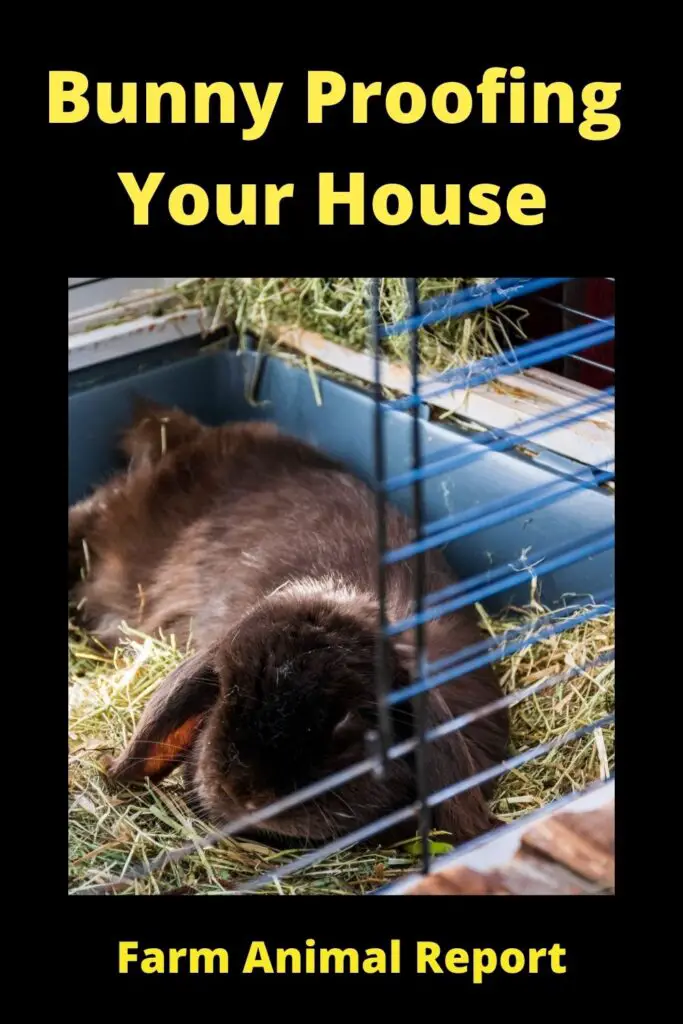
Chemicals
Keep all chemicals out of Bunny’s reach. Bunny might chew on the chemicals or ingest them. Bunny can be exposed to hazardous fumes so place Bunny in another room while you are working with these products.
– Store cleaners, disinfectants, and other household items out of Bunny’s reach
– Consider storing toxic materials under lock and key if possible when not using them for your Bunny’s safety
– Bunny might also eat through the containers, so make sure they are sturdy enough to withstand Bunny’s chewing.
Trash Containers
Trash Containers are very attractive to your little pet bunny. Bunny proof your trash containers by removing the lid, placing a plastic container with holes over it, or lining it with a metal window screen so Bunny can’t get his/her head stuck in there! They can be drawn to the smell of discarded food and even get a little daring and try to climb inside.
Bunny Digging
It is Completely natural for bunnies to burrow and dig. Bunny’s do this to hide their food and make nests. If you provide a digging box, Bunny will use it as a toilet. If Bunny is not provided with digging materials, Bunny may choose your garden or flower beds to dig and bury their food in.
Provide Your Bunny With A Digging Box
Bunny’s like to make nests and burrow away from danger. When Bunny has free roamed of the house, Bunny will try to burrow under your sofa or beds. Bunny’s are amazing diggers and can move dirt faster than you think possible. If Bunny is provided with a digging box, Bunny will happily use it instead of the flooring in your house or flowerbeds outside.
Chewing Toys
There are many chewing toys on the market that rabbits love. These toys are typically made out of wood, paper, or cardboard. All three materials will provide a rabbit with hours’ worth of chewing entertainment and can be safe if they do not contain any harmful chemicals such as glue or varnish.
They will do it so it is best to anticipate where they will chew and then try to direct them toward objects that are appropriate for chewing.
Some examples of items you can purchase that your rabbit would love to include:
Applewood sticks (bunny gets hours of entertainment chewing on these) – Bunnyloo Bunny Paper Board Scratcher (for rabbits who like to scratch rather than chew) –
Bunny Paper Corrugated Bunny Bed (for rabbits who like to chew)
Chinchilla Dusting Powder – CalciWorms Pet Treats (this is a treat that you can feed your rabbit daily. It has high calcium content and bunnies love it!)
It is important that toys are replaced regularly as they will become very dirty and can become a breeding ground for bacteria. Bunny owners should check toys daily to ensure that they do not have any rips or holes in them.
Bunny Paper Corrugated
Bunny Bed (for rabbits who like to chew) –
Bunny Wood Carrot Stick Treats (high calcium, bunnies love these!)
If your rabbit has become bored with his toys, you can put them in the freezer overnight to give your rabbit a new chewing experience.
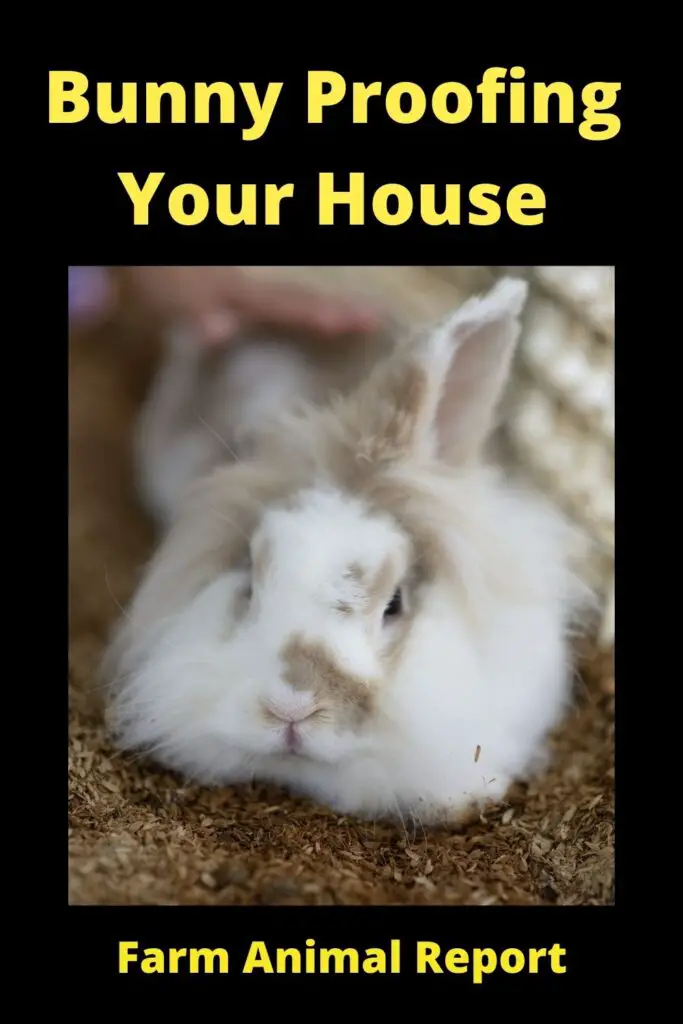
Litter Box – Bathroom
If your bunny is having a free run of your house, you will need to bunny proof the bathroom. Bunny urine is very strong and can leave a noticeable smell if they are not using their litter box correctly or if it’s not cleaned frequently enough. Try taking away any toilet paper that might be hanging around (bunnies like to chew on things).
Place their litter box in an area that is not used very often, if at all. This way they will be less likely to choose that area of the bathroom for their business. Bunny urine has a particularly strong smell so it’s best if you can place them away from people who are typically in this room with you (like your laundry hamper). If possible, put down some newspaper or a towel for them to use as their litter box, which you should replace with fresh newspaper or towels each day.
Make it as easy as possible to clean up your bunny’s litter box. Bunny urine can be very strong and will leave a noticeable smell if their litter is not cleaned regularly enough. Plus, some bunnies are picky about where they do their business so it may take them several tries before they get the idea that this area of the bathroom is for doing their business; in which case
Steps to Litter Train Your Bunny are
- Keep bunny on a regular feeding schedule so they will have to go potty at about the same time every day, which makes it easier for you to notice when he needs to use his litter box.
- Put hay in with the litter.
- Keep a clean box with fresh hay in it and your bunny will learn to use that box!
- Place the litter box where he goes, so he can smell his scent from previous times. Make sure not have too many boxes because rabbits like their territory very defined but if you find they are avoiding one of them then put it in an area they like until they start using the box again.
- If you find he is not using his litter box then sprinkle some of their droppings into the litter to encourage them to use that spot.
- Once your bunny has learned how to use his new litter boxes, when its time for him to go outside make sure you supervise him very closely and take your bunny to the same place every time so he will know where to go.
- As with any animal, always be patient and gentle! Rabbits can grow up to become big bunnies quickly but it takes some time for them learn their new environment especially if you introduce a new pet like another rabbit or a cat to your home.
Rabbit cage
In choosing a rabbit cage, you need to consider that it is large enough for the bunny to exercise. The minimum size of the cage should be at least two feet wide, two feet deep and three feet tall if there are no other pets in your home. If you have larger rabbits or multiple bunnies, then a bigger enclosure would be ideal.
The flooring of the cage should be solid enough that it cannot be easily chewed through.
Possible flooring options are:
A wire mesh bottom with a removable tray. Or, A plastic pan with a grid on top of it (not a metal grid). The plastic pan needs to have sufficient space between the grids so bunny feet don’t get caught in them. Or, Solid flooring. Keep in mind this limits the bunny’s movement if it is the only enclosure for him/her to use.
Hoping that your rabbit will choose one area of his cage to do his business and not go everywhere else adds an extra element of difficulty when training them. Allow at least two inches between the wall of the cage and the wire mesh to prevent your bunny from peeing out of his cage.
Food Bowl
Your Bunnies food bowl should be heavy enough that it can not be easily tipped over. Make sure to set the food bowl on a flat surface, you do not want your Bunny to have their food all over the floor! Also, make sure that no one will ever hit or knock into this dish and cause any problems for your furry friend
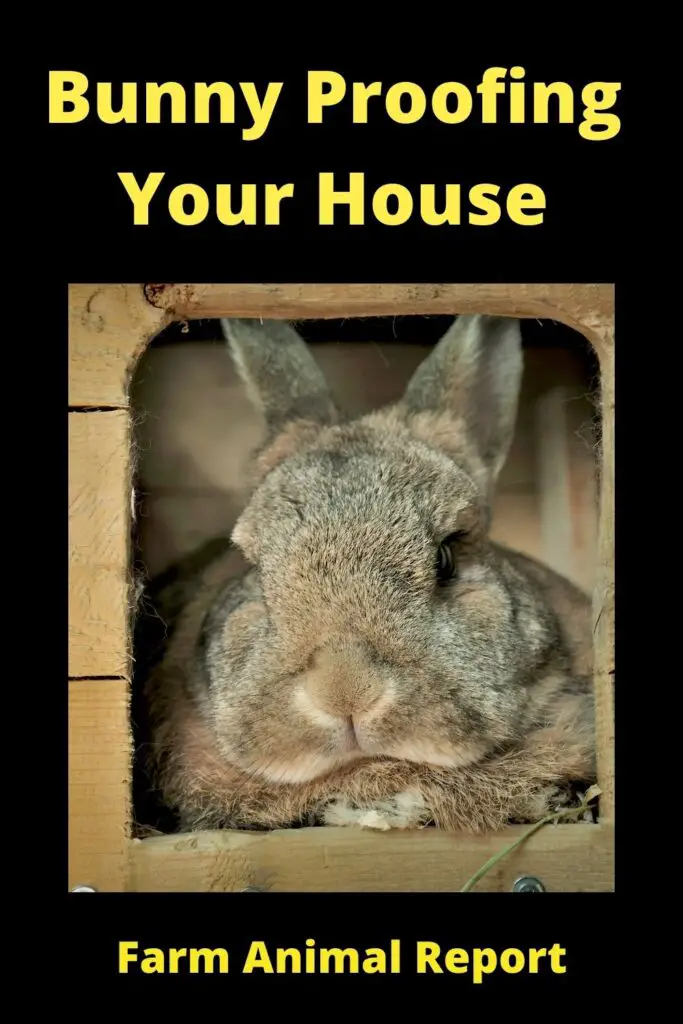
Water Bowl
Your Rabbits water bowl should be heavy enough that it can not be easily tipped over. Make sure to set the water bowl on a flat surface, you do not want your bunny’s water all over the floor! Also, make sure that no one will ever hit or knock into this dish and cause any problems for your furry friend
Final Thoughts
Sometimes it helps for you to get down on all fours and see from your rabbit’s viewpoint any item he would love to discover.


